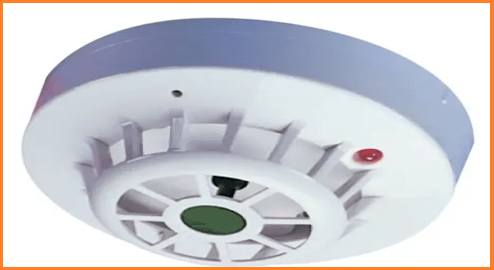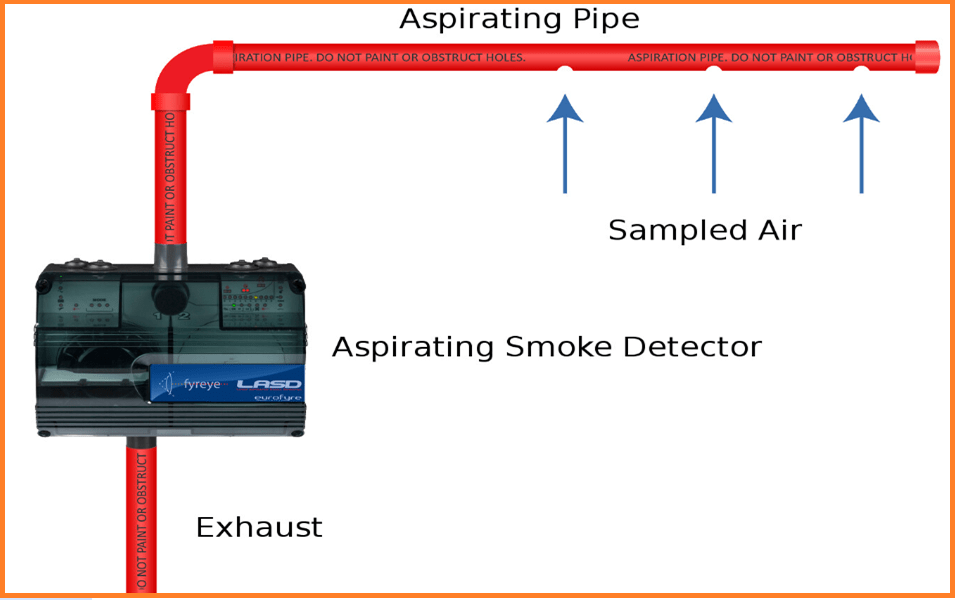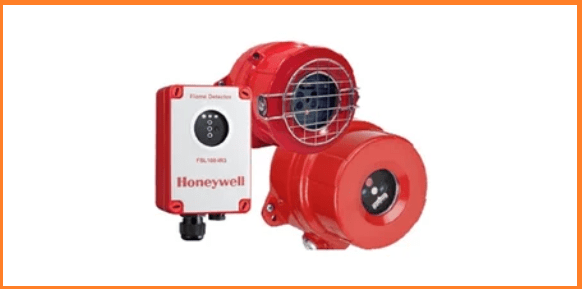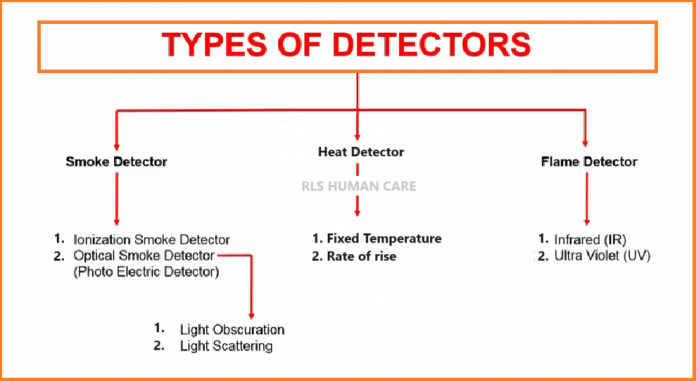Fire detection systems play an important role in the safety of life and property by providing early warnings of potential fire incidents. Various types of fire detectors are available, each designed to detect different types of fires based on their unique characteristics. In this post, we will discuss of the types of fire detectors and their working principles, shedding light on the diverse technologies that contribute to fire safety.
Contents
Types of Fire Detectors
- Ionization Smoke Detectors
- Photoelectric Smoke Detectors
- Heat Detectors
- Combination Detectors (combining ionization and photoelectric)
- Aspirating Smoke Detectors
- Flame Detectors
Ionization Smoke Detectors
Ionization smoke detectors are commonly used in residential settings. They contain a small amount of radioactive material (usually americium-241) that ionizes the air within the detector. When smoke particles enter the chamber, they disrupt the ionization process, causing a drop in electrical conductivity, which triggers the alarm.

Working principle of Ionization Smoke Detector
The ionization process involves the creation of ion pairs in the chamber. Smoke disrupts this process, causing a drop in conductivity and triggering the alarm. The ionization chamber contains a small, harmless amount of americium-241, which emits alpha particles that ionize the air.
Photoelectric Smoke Detectors
Photoelectric smoke detectors use a light source (usually an LED) and a photosensitive sensor. When smoke enters the chamber, it scatters the light, causing it to reach the sensor and trigger the alarm. These detectors are effective at detecting smoldering fires, which produce larger smoke particles.

Working principle of Photoelectric Smoke Detectors
These detectors use a light beam directed into a sensing chamber. When smoke particles enter the chamber, they scatter the light, allowing it to reach the sensor and activate the alarm. The alarm activates when a predetermined level of light scattering is detected.
Heat Detectors
Heat detectors are designed to respond to increases in temperature. They do not detect smoke and are often used in areas where smoke detectors may produce false alarms, such as kitchens. There are two main types: fixed temperature detectors (activate at a specific temperature) and rate-of-rise detectors (activate if the temperature rises rapidly).

Working principle of Heat Detector
Fixed temperature detectors activate when the ambient temperature reaches a specific pre-set level. Rate-of-rise detectors activate if the temperature increases rapidly, indicating a potential fire.
Combination Detectors (combining ionization and photoelectric)
Combination detectors incorporate multiple sensing technologies, often combining ionization and photoelectric capabilities. This allows them to respond to a broader range of fire types. These detectors provide a more comprehensive approach to fire detection and are commonly used in commercial and industrial settings.

Working principle of Combination Detector
Combination detectors combine the principles of ionization and photoelectric detection. This allows them to respond to both smoldering and fast-flaming fires. The detector analyzes the signals from both sensing technologies to determine whether to trigger the alarm.
Aspirating Smoke Detectors
Aspirating smoke detectors use a system of pipes to draw air from the monitored area to a central detection unit. The air is then analyzed for the presence of smoke particles. These detectors are highly sensitive and are suitable for environments where early detection is critical, such as data centers or museums.

Working principle of Aspirating Smoke Detector
Air is drawn from the monitored area through a network of pipes to the central detection unit. The air is then analyzed for the presence of smoke particles using sensitive detection methods.
Flame Detectors
Flame detectors are specialized devices that respond to the optical radiation emitted by flames. They are commonly used in industrial settings where traditional smoke detectors may not be effective. These detectors are capable of detecting flames in situations where smoke may not be readily produced, such as with gas fires.

Working principle of Flame Detector
Flame detectors use sensors that are sensitive to specific wavelengths of light emitted by flames. When the detector senses the characteristic light of a flame, it triggers the alarm.
Fire detectors are indispensable components of fire safety systems, and their effectiveness relies on the appropriate choice of technology based on the specific hazards of the environment. Understanding the working principles of different types of fire detectors is crucial for designing reliable and efficient fire detection systems that can mitigate the risks associated with fires. As technology continues to advance, the development of new and improved fire detection methods remains a key focus in ensuring the safety of individuals and properties.
Frequently Asked Questions (FAQ) for Fire Detectors
Q: What is a fire detector? A: A fire detector is a device designed to identify the presence of a fire by sensing specific indicators, such as smoke, heat, or flames. Its primary function is to provide an early warning to occupants and initiate appropriate response actions to mitigate the potential damage caused by a fire.
Q: How does a fire detector work? A: Fire detectors operate based on different sensing technologies. Common types include ionization smoke detectors (detecting changes in ionized air), photoelectric smoke detectors (using light scattering), heat detectors (responding to temperature changes), aspirating detectors (drawing air for analysis), and flame detectors (sensing infrared or ultraviolet radiation emitted by flames).
Q: What are the types of fires that fire detectors can detect? A: Fire detectors are designed to detect various types of fires, including fast-burning, flaming fires (detected by ionization detectors), slow-burning, smoldering fires (detected by photoelectric detectors), high-temperature fires (detected by heat detectors), and open flames (detected by flame detectors).
Q: Where should fire detectors be installed? A: Fire detectors should be strategically placed throughout buildings, considering factors such as the size of the area, the type of occupancy, and potential fire hazards. Common locations include bedrooms, hallways, kitchens, and near potential sources of fire, such as stoves or electrical panels.
Q: Can a fire detector detect all types of fires? A: No single type of fire detector can detect all types of fires effectively. That’s why a combination of detectors, such as dual-sensor smoke detectors or combination detectors, is often recommended to provide comprehensive coverage across a range of fire scenarios.
Q: How often should fire detectors be tested? A: Fire detectors should be tested regularly according to the manufacturer’s recommendations, typically monthly. This involves pressing the test button to ensure the alarm sounds and checking the batteries. Additionally, professional maintenance and testing may be required annually.
Q: What are false alarms, and how can they be prevented? A: False alarms occur when a fire detector is triggered without the presence of an actual fire. This can be caused by cooking fumes, steam, dust, or other airborne particles. To prevent false alarms, it’s important to install the appropriate type of detector for the environment and to keep detectors clean and well-maintained.
Q: Can fire detectors be interconnected? A: Yes, many fire detectors can be interconnected within a building. When one detector detects a potential fire, it can signal other interconnected detectors to sound alarms throughout the premises. This ensures that occupants are alerted to the danger regardless of their location within the building.
Q: What is the lifespan of a fire detector? A: The lifespan of a fire detector depends on the type and model. Ionization and photoelectric smoke detectors typically last 10 years, while heat detectors may have a longer lifespan. It’s important to follow the manufacturer’s recommendations for replacement and regularly check for expiration dates on detectors.
Q: Are there regulations regarding the installation of fire detectors? A: Yes, building codes and regulations often dictate the placement and type of fire detectors required in different occupancy types. It’s crucial to adhere to these regulations to ensure the safety and compliance of the building.





